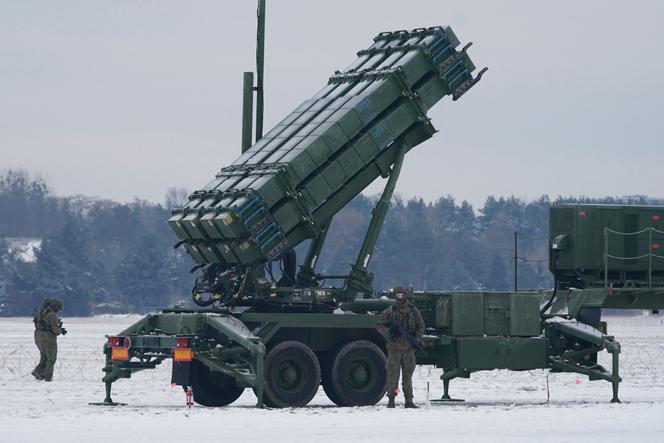
While Ukraine has announced several times in recent weeks that it has shot down the hypersonic Kinzhal missiles fired in salvos at Kyiv thanks to the two Patriot systems supplied by the United States and Germany, Moscow has embarked on a game of bluff using its best poker face about the success of its equipment – all the while questioning the effectiveness of the enemy's defenses. Let's review the origin and functioning of the American missile system.
What is the Patriot?
Designed in the late 1960s, the Patriot system was developed by Raytheon, an American multinational aerospace and defense conglomerate headquartered in Arlington, Virginia. Its acronym name comes from the radar part of the weapon system: It stands for Phased Array Tracking Radar to Intercept On Target. The Patriot originally fired MIM-104 missiles, a medium-range surface-to-air missile developed to intercept high-flying aircraft; it was later upgraded to a missile defense system.
In a briefing paper published earlier this year, the Congressional Research Service, the US federal agency under Congress that conducts public policy research, delivered an accurate description of the Patriot system, drawing on information provided by NATO and Raytheon.
According to the report, a Patriot battery includes a generator that powers the battery, a radar that provides target detection and tracking as well as fire control, jammers, a control station that calculates trajectories and controls the firing of missiles, launcher stations – usually four – with four PAC-2 missiles or 16 PAC-3 missiles. A Patriot battery is served by about 90 soldiers and can be dispersed over an area of several square kilometers on the ground, making it unlikely that a single missile will destroy a battery.
The PAC-2 missiles, with a range of 160 kilometers, use a proximity fuse, which explodes near a missile to be intercepted. The PAC-3, with a range of only 40 kilometers, but more accurate (thanks to an on-board radar) was designed to intercept and destroy missiles on a hit-to-kill basis, colliding with its target. The batteries are typically deployed with five to eight launchers equipped with a mix of PAC-3 and PAC-2 missiles.
According to CNN, which cites defense officials and members of Congress, Ukraine has also used the Patriot system to shoot down at least one Russian fighter jet flying far from the front. Russian aircraft generally stay behind Russian lines, making them difficult to shoot down by the NASAM surface-to-air missile batteries used by Ukraine, which have a shorter range.
A billion-dollar system
The Center for Strategic and International Studies (CSIS) estimates that each Patriot battery costs about $1.1 billion: $400 million for the system, $690 million for the missiles – the cost of a single missile is estimated at $4.1 million (€3.8 million).
Dominika Kunertova, a researcher at the Center for Security Studies at the Swiss Federal Institute of Technology in Zurich, believes that "the Patriot system makes a significant and cost-effective contribution to Ukraine's capabilities: Its interceptions are cheaper than the Russian Kinzhal, which cost an estimated $10 million per unit.
She added that Ukraine's claims that all Russian missiles, including Kinzhal missiles, were intercepted by air defense should be taken with caution. "The Ukrainians must absolutely claim that they managed to shoot down all Russian missiles. But we should not forget that Russian missiles have low reliability and accuracy rates – in-flight breakup, navigation error, missiles that do not explode on impact – which may contribute to our overestimation of Patriot's success," she explained.
Deployment since the first Gulf war
Considered one of the best air defense systems in the Western military, the Patriot was first deployed during Operation Desert Storm in the first Iraq war (1990-1991) to protect Israel and Saudi Arabia from the Russian-made Scuds used by Saddam Hussein's army.
Their effectiveness has been the subject of much controversy. On February 25, 1991, a Scud hit a US base in Dhahran, Saudi Arabia, killing 28 soldiers. An investigation by the Government Accountability Office uncovered a software error in its coordination system. Two researchers, Theodore Postol of the Massachusetts Institute of Technology and Reuven Pedatzur of Tel Aviv University, then claimed that the Patriot system had a success rate of less than 10%.
Since then, the system's performance has improved: During the 2003 US invasion, all ballistic missiles fired by Iraq were intercepted by the system. At the same time, the Patriot's use has been blamed for the destruction of two fighter jets: one British and one American. In 2005, a report by the Department of Defense noted that "there is often insufficient data to pin down the exact causes of failure."
Israel has repeatedly used them against Hamas drones, fighter aircraft, and aircraft from Syria. In the missile war in Yemen, Patriots used by Saudi Arabia and the United Arab Emirates have intercepted Houthi missiles and drones with varying degrees of success.
In December 2022, Volodymyr Zelensky had said he hoped that this air defense system would "significantly" strengthen Ukrainian defense against Russian strikes. In the meantime, the Ukrainian military's communications department continues to mock Vladimir Putin, who called the Patriot a "rather old system" to which Russia would find "an antidote."
Ukraine is keeping a careful eye on its Patriots. On Wednesday, for example, Ukraine's security services announced that they were prosecuting six Kyiv residents who shared images of Ukrainian air defense on social media during the attack on Kyiv on May 16. While their images showed the destruction of the missiles, they may also help the Russians by revealing the positions of Ukrainian equipment.